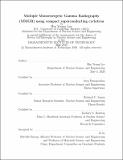Multiple Monoenergetic Gamma Radiography (MMGR) using compact superconducting cyclotron
Author(s)
Lee, Hin Yeung.
Download1191905349-MIT.pdf (5.037Mb)
Alternative title
Multiple Monoenergetic Gamma Radiography using compact superconducting cyclotron
MMGR using compact superconducting cyclotron
Other Contributors
Massachusetts Institute of Technology. Department of Nuclear Science and Engineering.
Advisor
Areg Danagoulian.
Terms of use
Metadata
Show full item recordAbstract
Smuggling of special nuclear materials (SNM) and nuclear devices through borders and ports of entry constitutes a major risk to global security. Reliable technologies are imperative for screening the flow of commerce for the presence of high-Z materials such as uranium and plutonium. This thesis presents an experimental proof-of-concept system using low energy (p, p2) nuclear reactions to generate monoenergetic photons to provide a means to measure the areal density and the effective atomic number (Zeff) of an object with accuracy that surpasses existing interrogation methods and other major deployed systems. This radiography system was designed using an ION-12SC compact superconducting 12 MeV proton cyclotron. Using a specially designed hybrid graphite water target, monoenergetic photons were generated at 4.4, 6.1, 6.9, and 7.1 MeV from (p, p2) nuclear reactions. By performing GEANT4 simulations and numerical integration on existing cross sections, the gamma yield from MMGR are shown to be comparable to the X-ray yield from a bremsstrahlung-based system, with the advantage of lower radiation dose using MMGR. In a series of MMGR experiments using 4.4, 6.1, 6.9, and 7.1 MeV gammas, the author gamma transmission spectra on a variety of homogeneous (Z from 13-92) and heterogeneous mock cargoes. With the newly developed reconstruction algorithm, the author accurately predicted the areal density and Zeff of the experimental cargoes with an average Zeff reconstruction accuracy of 3.7 and an uncertainty of 6.2. The experimental results were also used to perform extrapolation and performance estimations for a future theoretical deployable system with higher beam current and proton energy for improved reconstruction precision. In addition, a penetration study following the ANSI N42.46 standard was performed, demonstrating a maximum penetration thickness of 45 cm with a hypothetical beam current (14 [mu]A) and scanning speed (4 cm/s). In conclusion, MMGR using compact superconducting cyclotron was demonstrated to be a low-dose and mobile method to screen commercial cargoes with high material specificity, provided a means of distinguishing benign materials from SNM to prevent the smuggling of SNM and improve overall global security.
Description
Thesis: Ph. D., Massachusetts Institute of Technology, Department of Nuclear Science and Engineering, May, 2020 Cataloged from the official PDF of thesis. Includes bibliographical references (pages 151-161).
Date issued
2020Department
Massachusetts Institute of Technology. Department of Nuclear Science and EngineeringPublisher
Massachusetts Institute of Technology
Keywords
Nuclear Science and Engineering.